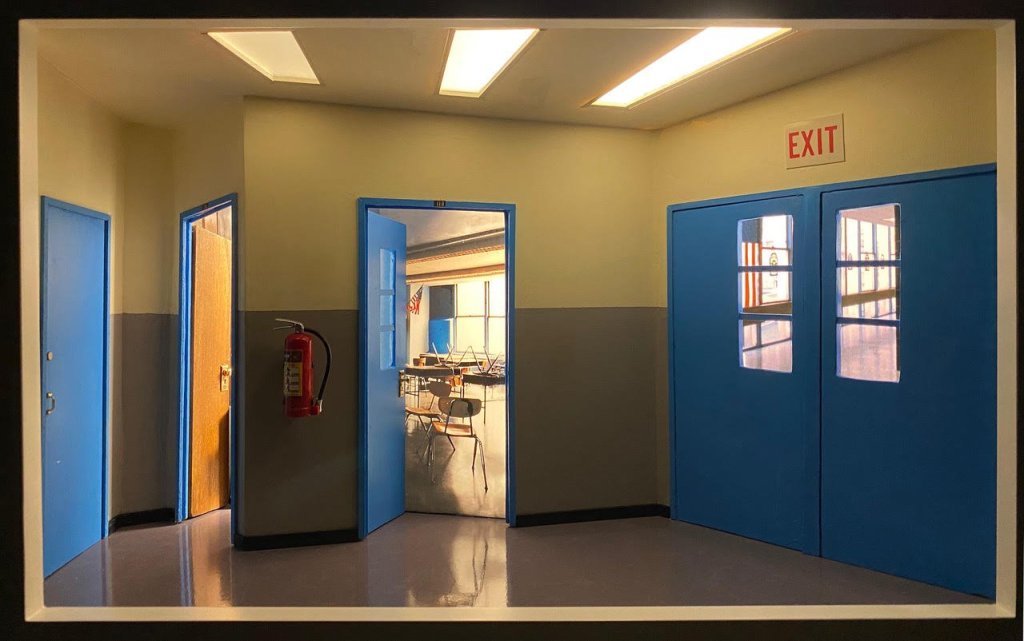For some of us, the memories of being in school are sharply etched into our psyche. When I think about my experiences as a public school student (twenty years ago!), I can close my eyes and envision the sights and sounds throughout the school building, and how it felt to be there in the moment. For those of us who teach, the transition from being a student to an educator, brings a whole new set of sensory qualities, emotions and cognition to the school environment.
The overall school setting has a tendency to overwhelm one’s body and mind. If I could characterize its design in one word, it would be: institutional. The sheer size of the brick and mortar building elicits a multitude of responses. Its maze-like hallways fill up and empty out period after period, providing a cacophony of reverberated voices, squeaky shoes hustling along waxy floors and the clanking of metal lockers. These corridors are like arteries and veins, delivering students, teachers and administrators to various classrooms and offices.
While a school’s architecture provides the skeletal structure for the learning environment, it is the students and faculty that give the school its heart, soul and identity. Although their construction is largely uninspired, schools are vessels for social and intellectual development. They are sites for momentous achievement and growth, but also one of serious trauma.

For an artist like Susan Leopold, who has spent ample time as an artist-in-residence within New York City public schools, the buildings inspired a range of visual symbolism. Leopold intricately transformed the cavernous and gargantuan architecture of schools, into intimate dioramas, while still retaining their vitality and essence. Her series of small wall-mounted sculptures represent vacant classrooms, hallways and offices of schools as an aesthetic exploration into abstraction, as well as a conceptual investigation of memory, juvenescence and the contrasting nature of schools as both sanctuary spaces and danger zones.
One of the first things that raced through my mind as I looked at these sculptures was the zeitgeist of 2020. That year will be infamously synonymous with so many metamorphic social, cultural and emotional events. On an educational scale, it was full of unfamiliarity and uncertainty. Because of the pandemic, schools across the world closed their physical buildings for at least a full academic year. The shift to remote learning was abrupt, and despite it being a necessity due to the risks from an unprecedented public health crisis, it has had mixed results thus far because of its economic, social and psychological impact on students and families (see: Morgan, 2020).

Courtesy of the artist and Elizabeth Harris Gallery.
The closure of schools drained the physical buildings of their lifeforce. Hallways, classrooms and other onsite facilities were enveloped by the dark and an unsettling and unusual silence. Leopold’s small architectural sculptures succinctly capture this overwhelming feeling through vignettes of school interiors without any of the usual school activities. Leopold reflects that “the institutional quality of the spaces seemed in sharp contrast to the humanity that filled the halls and classrooms daily.” Left without any trace of students and faculty the school feels very cold and barren.
Leopold’s sculptures are in dialogue with the history of artworks that envision schools as subject matter. In a post titled, Portraying Pedagogy’s Progress, I wrote about what artistic representations of classrooms, teaching and learning tell us about how a society’s positions on education have progressed over time. Her sculptures are in stark contrast with French painter Henri Jules Jean Geoffroy’s early twentieth century depictions of classrooms and warm interactions between teachers and students; but they are well paired with Catherine Wagner’s American Classroom series of photographs. Both Leopold’s sculptures and Wagner’s black and white photographs of empty classrooms resemble artifacts of the learning process and educational policy. Without an actual human presence, the environments that they each document, elicit our own memories and feelings about education and our culture at large. While Wagner’s photographs often show recent evidence of student and teacher activity (i.e. freshly erased marks on the chalkboard), Leopold’s sculptures render school settings as inoperative.
After a tumultuous and disruptive span of time, which included the shuttering of schools, and a continuity of violent incidents when they reopened, Leopold’s architectural sculptures express the anxiety and nostalgia associated with traditional school aesthetics. There is a great deal to learn from viewing these works of art, such as how the institutionalized school setting communicates our collective values on education, safety and compassion. Perhaps it is time we reevaluate whether these physical spaces and the frameworks which dictate how they are run, are truly supporting the needs and overall well-being of the students, teachers and administrators who animate and are the crux of the school building.
Leopold’s work is currently on view in a solo exhibition titled, School(s), at the Elizabeth Harris Gallery in New York City through February 19, 2022.
References, Notes, Suggested Reading:
Morgan, Hani. Best Practices for Implementing Remote Learning during a Pandemic, The Clearing House: A Journal of Educational Strategies, Issues and Ideas, vol. 93, no.3, 28 April, 2020, pp. 135-141, DOI: 10.1080/00098655.2020.1751480. Accessed 3 December 2021 https://www.tandfonline.com/doi/full/10.1080/00098655.2020.1751480.

The rectilinear archtecture of our establishment institutions is possibly unconsciously intended to condition us how to behave/think ?
LikeLiked by 1 person
Indeed. I’d say consciously intended in many cases, i.e. the panopticon.
LikeLiked by 1 person
Big Hallway Monitor is watching you.
LikeLiked by 1 person